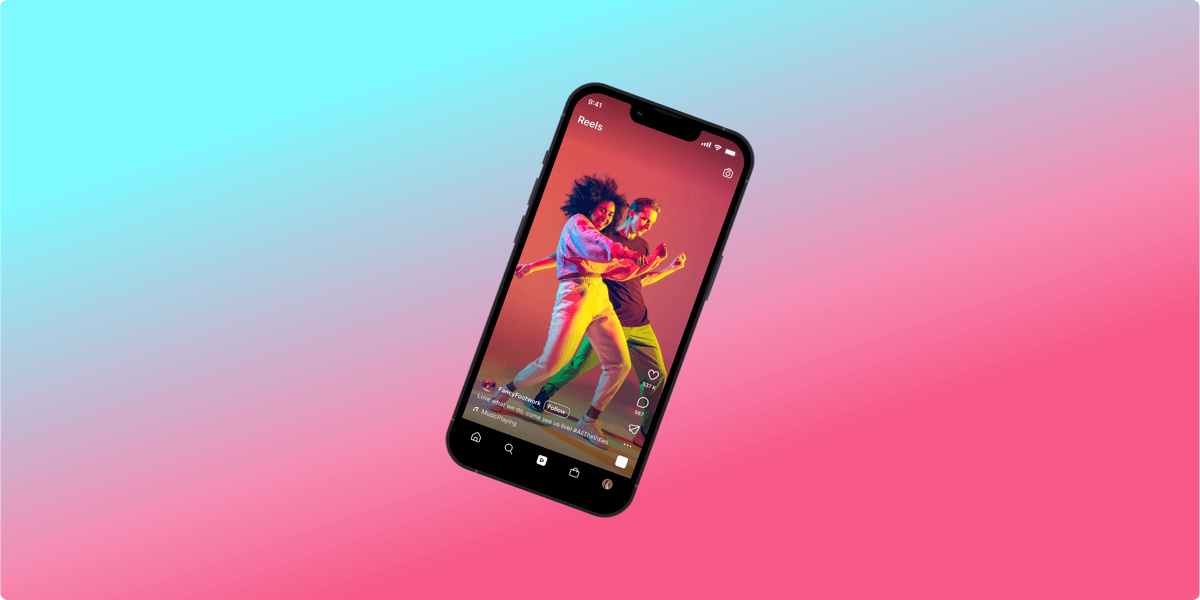The prevalence of shoppable ads is growing rapidly.
Thanks to investment from global tech companies and media owners looking for a share of the expanding ecommerce market, shoppable ads are already available on social, search, streaming TV, and programmatic, and there are emerging augmented reality (AR) and virtual reality (VR) use cases.
Born out of a recognition that people are increasingly looking to their favorite digital media platforms for inspiration, shoppable ads allow them to explore and purchase products directly through advertising. Unlike traditional online ads that redirect to a brand’s website, shoppable ads mean people can complete their purchase without leaving their immediate environment.
For consumers, shoppable ad formats offer novel shopping experiences and convenience in purchase. For brands, they offer a new channel for ecommerce sales, a streamlined purchase journey, and effective attribution – which will be especially important in 2024 as brands look for new ways to close the loop between impressions and conversions.

Social Commerce Opportunity
Shoppable ads are part of a wider move toward social commerce, where digital media platforms blur the lines between social and commercial features to keep users within their platforms, increase engagement, and ultimately boost revenues.
And the social commerce opportunity is huge. Sales through social platforms are expected to reach $82 billion in the US and $7 billion in the UK by 202613.
Industry commentators predict social commerce will revolutionize the way people shop and interact with brands, and livestream shopping is a perfect example14. This experience, which already enjoys huge popularity in China, sees brands embed shoppable links into livestream content so viewers can make direct purchases, often with exclusive access or a discount. As it gains traction in the US and UK, livestream shopping will help brands engage in more meaningful customer interactions, and achieve conversion rates that can be 10 times higher than standard ecommerce, according to McKinsey15.
As brands increasingly blend commerce and content across a variety of channels, shoppable ads – which are frequently powered by AI – will help them deliver interactive experiences that increase customer engagement, cultivate deeper relationships, and give them a competitive edge.
“The main risk that businesses need to be wary of is surfacing products in your shoppable ads that are not in stock, and so you lose that conversion and potentially damage brand perceptions as well. Businesses also need to ensure that the customer can experience the brand somewhat through the ad. Otherwise you run the risk of converting a customer who might not even know what the brand is, or remember it for future purchases.”
Head of Performance Marketing, multinational retailer
The state of shoppable ads in 2024
Social media: On Facebook, Instagram, TikTok, Pinterest, and YouTube, brands can create shoppable ads that link directly to a digital storefront.
User‐generated content and sponsored posts: On Instagram, brands and influencers can add shopping tags to sponsored posts and reposts of customer-created content, so users can purchase featured products through a digital storefront.
Digital video or audio: YouTube and TikTok offer shoppable ads for video content, with pop-ups or links embedded in the video description enabling users to purchase featured products. For example, Milk Bone dog treats ran an audio campaign on Amazon Music that allowed listeners to add the product to their cart through a voice command to Alexa while the ad was playing.
Livestream shopping: TikTok and YouTube allow brands and influencers to overlay shoppable links for the products that are featured in live video content.
AR/VR: Brands are exploring shopping within AR and VR experiences. For example, customers of global makeup brand Charlotte Tilbury can select and buy products in its virtual world.
Streaming TV: NBCUniversal enables on-air shoppable moments, where viewers can scan a QR code to purchase using their smartphone. Roku has partnered with Walmart to enable shopping directly from the TV set, with viewers’ payment details pre-populated from Roku’s payments platform.
Search: Google and Microsoft enable users to purchase directly through the ads that appear in search results. In some cases, users are sent to merchants or other marketplaces to process payment.
Visual search: Shoppers can use their smartphone camera to perform a visual search for an item they see (online or offline) and receive shoppable ads for that product or similar products.
Case Study
L’Oréal increases sales with livestream shopping
L’Oréal has introduced livestream shopping into its marketing mix with great success. The brand runs livestream makeup tutorials across YouTube and Instagram with senior makeup and skincare experts, who show viewers how to achieve specific looks using L’Oréal products, and popular influencers, who answer questions and provide additional advice. During the livestream, L’Oréal encourages participants to purchase featured products by seamlessly integrating shopping links. It creates hype with calls to action like “almost sold out” or “click link for a 20% discount.”
L’Oréal has already held 50 livestream shopping experiences across five countries, which feel like a one-on-one consultation at a makeup counter. The unique, personalized experiences increase reach, customer engagement, and of course sales.
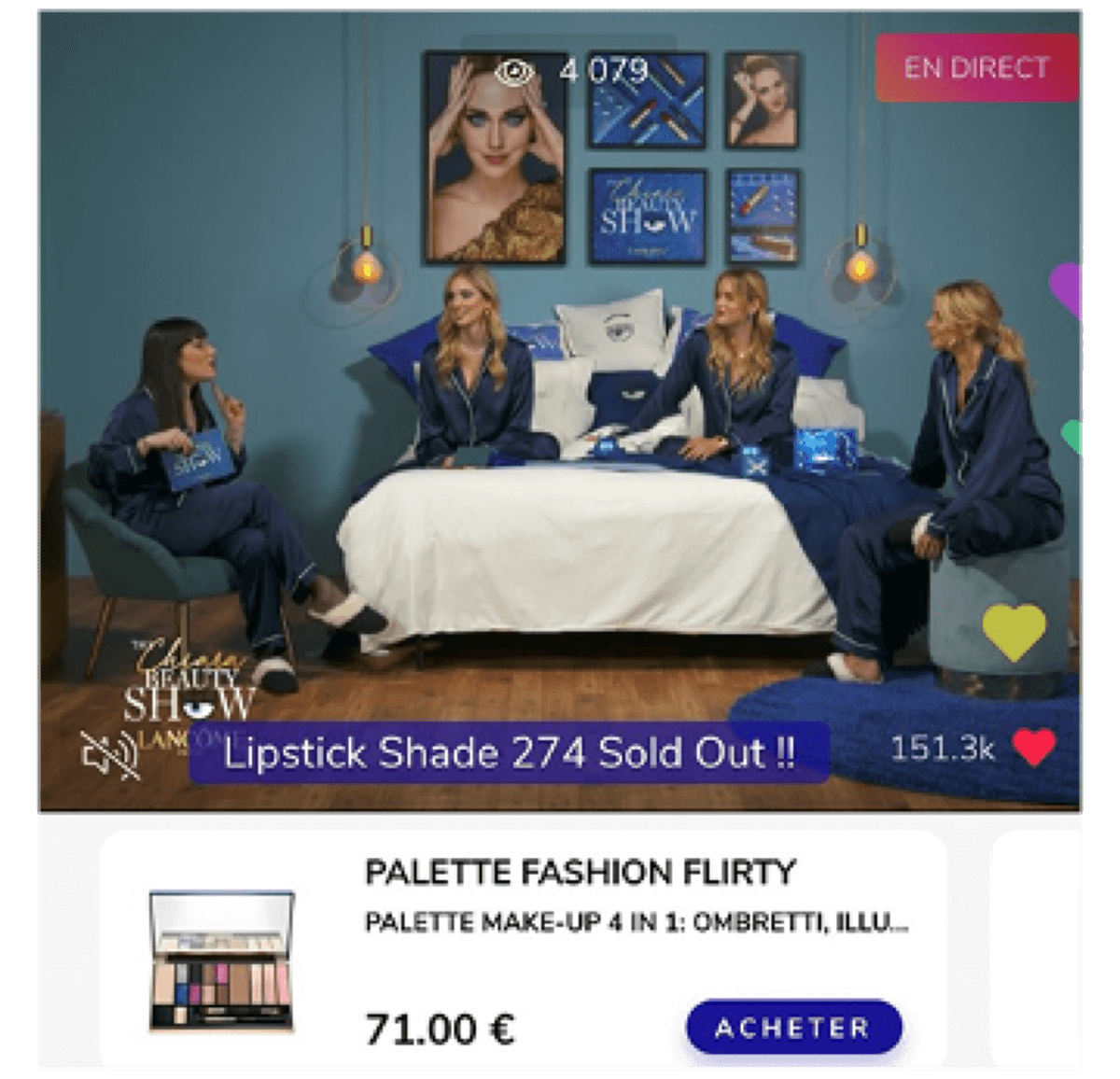
Consumer perspective:
Shoppable ads provide a more immersive and interactive shopping experience
Shoppable advertising is still relatively new to people. While the majority of US and UK consumers (62%) are aware of shoppable ads16, only a small percentage have purchased through them (see right). Perhaps unsurprisingly, use of shoppable ads tends to be higher among younger age groups, but even there shoppable ads only account for a small proportion of ecommerce sales.
Uptake of shoppable ads among consumers17
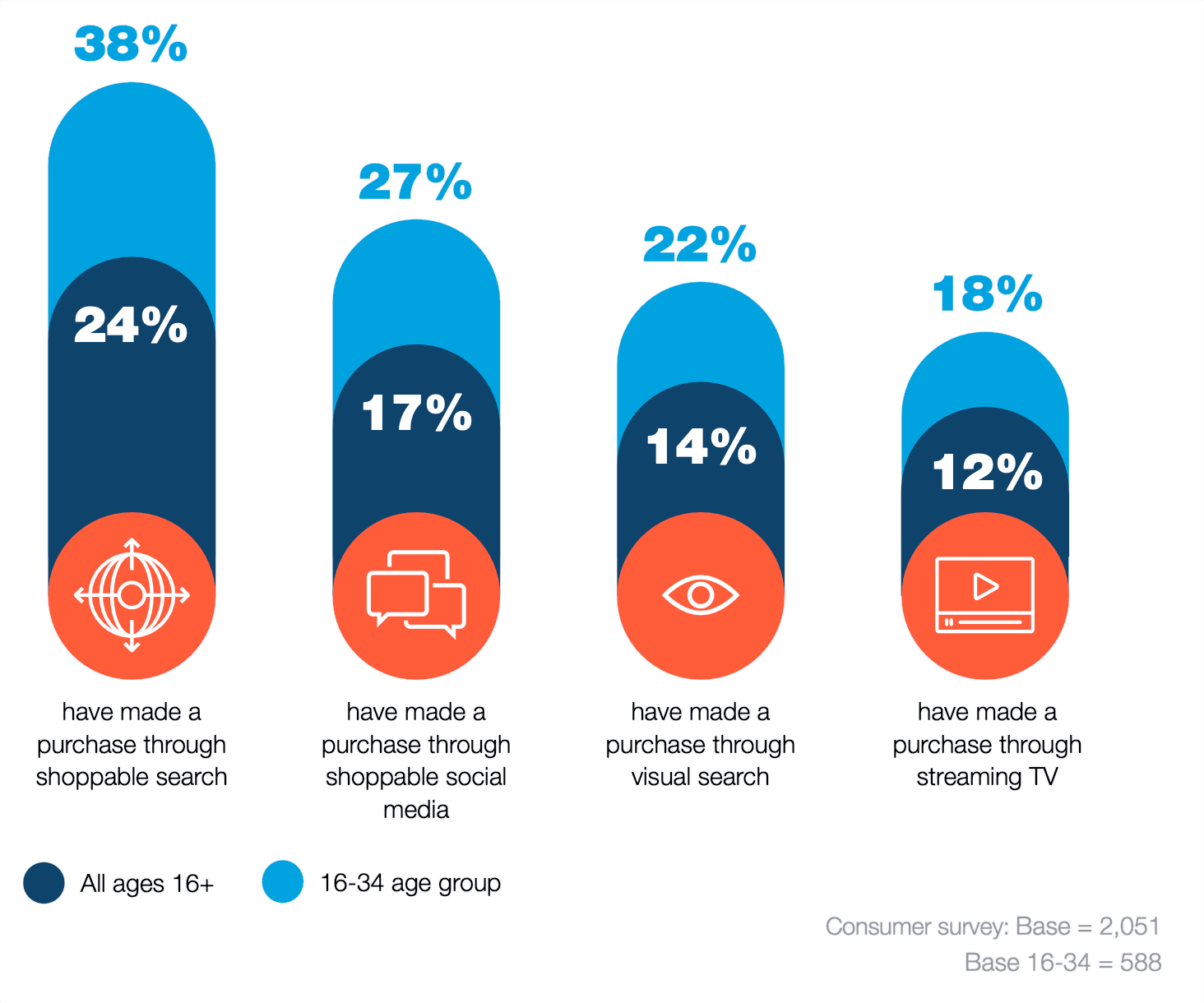

While the use of shoppable ads may still be low, most of the consumers who have used them feel that they enhance the online shopping experience in multiple ways.
Discovering products that are relevant to their interests.
66% of consumers who have used shoppable ads say the ads enable them to find the products and services they’re interested in more easily18. With 58% of 16-34 year olds saying they like it when companies recommend products or services that are tailored to their personal preferences19, this is a notable benefit of shoppable ads.
Making shopping easier and more convenient.
63% of consumers who have used shoppable ads say they enable them to buy products and services in a more efficient way20. This could mean both shortening the shopping journey, perhaps with one-click purchase, and making it easier to find what they want. Indeed, over half (52%) of consumers feel it’s useful when brands gather their information to show ads related to a product or service they’ve browsed or purchased on a different site21.
Purchasing products on their most used platforms.
64% of consumers who have used shoppable ads say they enable them to access a larger range of channels and platforms to shop from22. Shoppable advertising is a unique experience, presenting people with new and entertaining ways to discover and purchase products on the channels they already use.
People do have some reservations about making purchases via shoppable ads. For instance, only 3% of consumers say they would actively choose to purchase financial services products via a shoppable ad, and 4% say the same for automotive and homeware products23. In these categories, physical stores and “traditional” online avenues continue to dominate given the nature of the products.
But with the continued expansion of retail media networks and other forms of shoppable media, people are likely to become more accustomed to seeing shoppable ads, which should encourage increased engagement and address any concerns.
Overall, consumers are positive about the use of shoppable ads, as long as the experience is convenient, relevant to their personal interests, and allows them to stay within the digital environments where they’re most comfortable.
Business perspective:
Shoppable advertising helps brands close the gap between impressions and conversions
Types of ads organizations have deployed
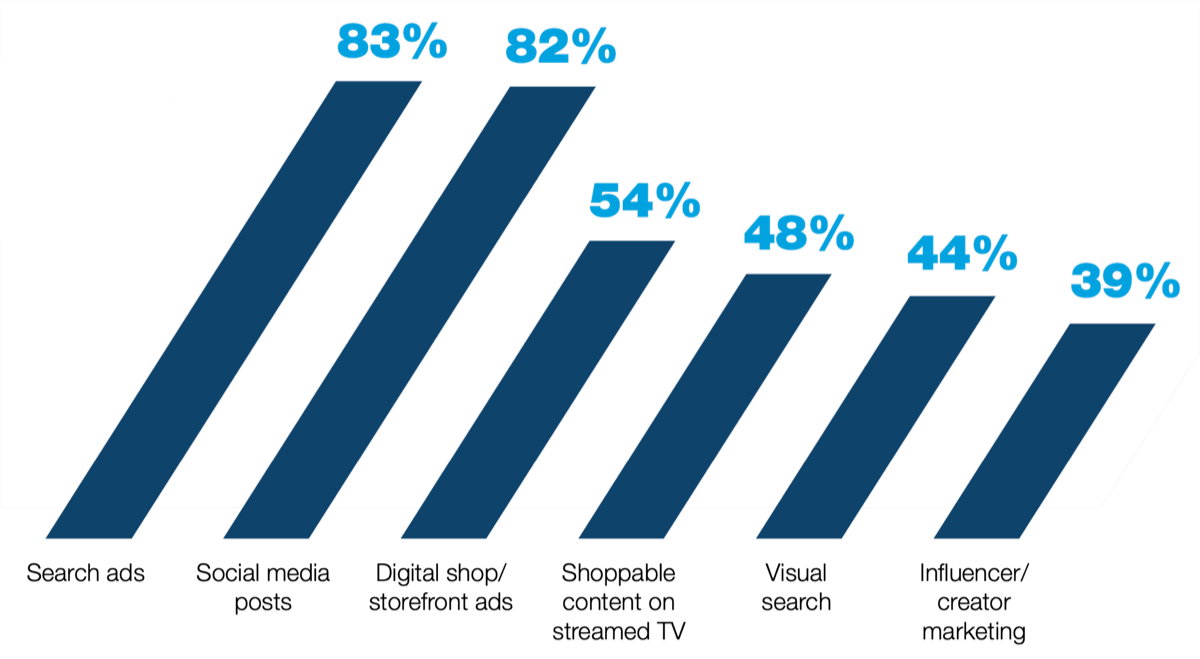
Business survey: Base of companies currently using shoppable advertising = 89
Shoppable ads are somewhat more established with brands than with consumers. Almost half (45%) of professionals surveyed said their company has already deployed shoppable ads24, with most use cases centered on search ads (83%) and static shoppable images on social media (82%)25.
Brands that have deployed shoppable ads also plan to explore other formats
But, as was the case with consumers, the brands that have used this type of advertising do see the benefits and are keen to explore further. Of those that currently use shoppable advertising:

Business survey: Base of companies currently using shoppable advertising = 89

This interest in shoppable ads can be explained by their ability to remove friction from the “messy middle” of the purchase journey. When brands can connect people with products in the digital environments they are already using, they can shorten the path to purchase. Reducing the number of touchpoints required to convert a lead lowers the cost of acquisition and improves ROI over the long term.
Other key benefits include:
Gain data for personalization: Shoppable ads help brands understand which products customers are interested in, including details such as their price range, color, and size. This information can be used to deliver more relevant ads in the future. Over half (56%) of professionals who have already used shoppable ads see this as a benefit27, (as do 38% who have not yet tried the format)28.
Increase engagement and conversion rates: Nearly half (42%) of companies that have used shoppable ads believe the format can drive increased engagement and conversion rates29, as consumers are receptive to recommendations while on the platforms they use to discover products. Over a third (37%) of those who have not yet used shoppable ads also expect this to be a benefit30.
Close the loop between impressions and conversions: The short purchase path and closed loop nature of shoppable ads makes attribution easier. It allows advertisers to track the performance of their campaigns and optimize in real time. Nearly a quarter (21%) of those that have used shoppable ads see more effective attribution as a key benefit of the format31, and 10% of those that haven’t yet used them also identify it as a potential benefit32.
Reach and acquire younger shoppers: Gen Z and young Millennials already use social media to discover and shop for products. They’re looking for more engaging and interactive shopping experiences than traditional ecommerce sites and shopping apps can offer. Shoppable ads can help brands reach and convert these younger customers.
Uptake of shoppable ads by age group33:
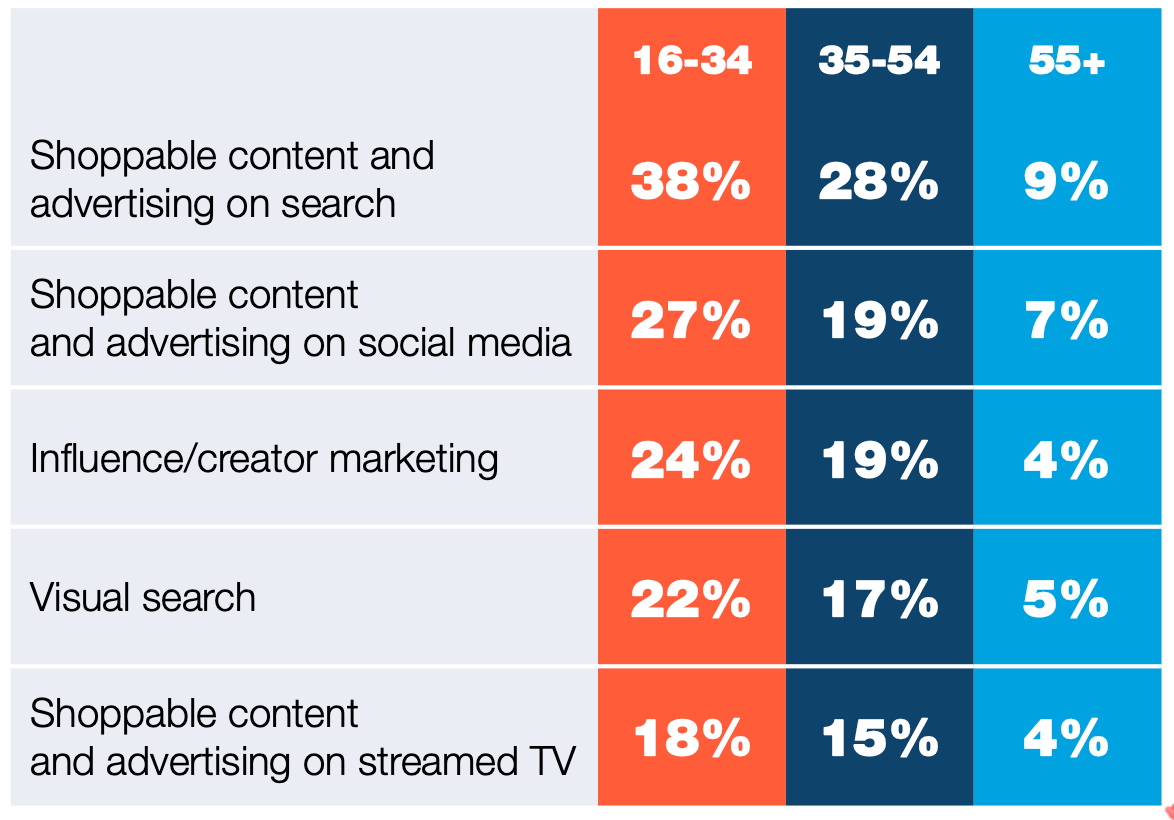
Consumer survey: Base = 2,051
Making it work:
To capitalize on shoppable ads, brands need to be able to unify customer data across platforms for personalized experiences
Data will play a critical role in helping businesses use shoppable ads to deliver meaningful experiences by featuring relevant products and messages. Brands will need high-quality first-party data that reflects people’s continually evolving desires, perceptions, and life stages.
In fact, businesses must be able to collect and unify customer data across first- and third-party platforms to form a single customer view in order to deliver relevant shoppable ads that deliver the best possible CX.
To deliver successful shoppable ad campaigns, businesses will need a seamless, real-time flow of data between customer data, product and inventory management systems, and marketing automation systems. This will ensure that only products that are in stock and available to the customer are displayed in shoppable ads. Businesses will also need to maintain up-to-date information about products in their brand catalogs to avoid discrepancies across channels.
Furthermore, as audiences engage with shoppable ads across a number of platforms and devices, businesses will need sophisticated tracking and measurement capabilities to capture all relevant customer interactions.
Where next?
AI is already being used to power the decision making behind shoppable ads and personalize the experience. In 2024, we’re likely to see product innovation from big tech and media companies that further integrates AI into shoppable advertising, including:
Conversational shoppable ads:
By accessing a wealth of data, AI assistants can be used for conversational commerce, learning about an individual’s preferences so they can recommend products they’ll love. This will take two forms:
- Integrating shoppable ads into LLMs (e.g., ChatGPT, Bard): As tech platforms race to monetize their LLMs, we can expect to see shoppable ads integrated into conversational AI search. Google and Microsoft are already experimenting with these formats, which use generative AI to create high-quality customized ads.
- Ads with conversational function: In the near future, shoppable ads will have embedded conversational functionality, so customers can ask questions about the product, explore options, and complete the purchase all within the ad.
Using generative AI to deliver highly personalized shoppable ads:
We expect to see brands using generative AI to create highly personalized shoppable advertising content at scale and at a lower cost. AI can draw on different data sets to analyze customer preferences in great detail, creating shoppable content that is highly relevant to the individual (e.g., by including their favorite color and aesthetic).
